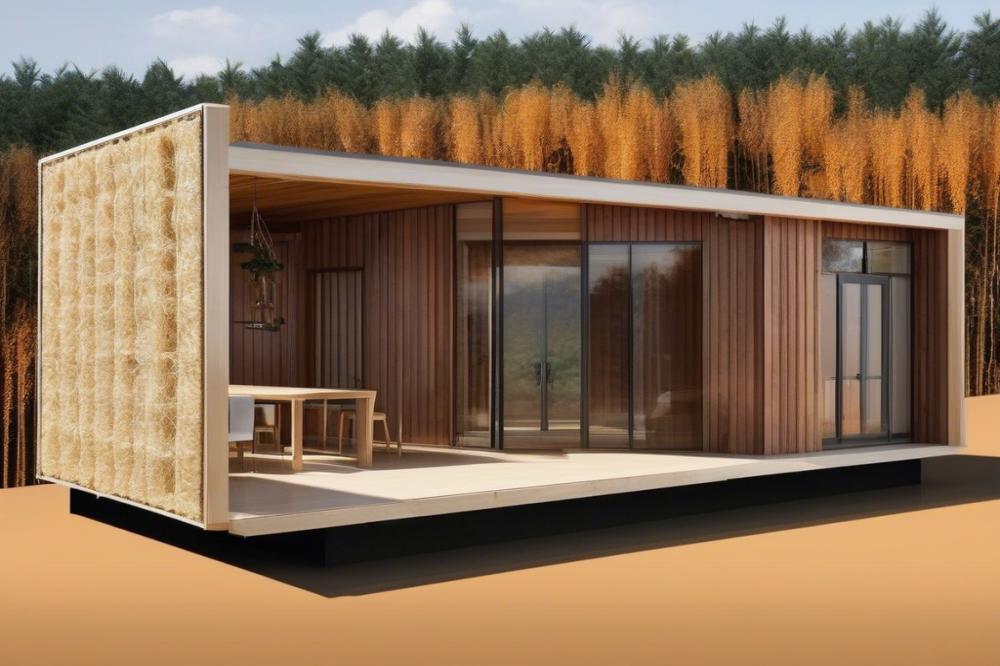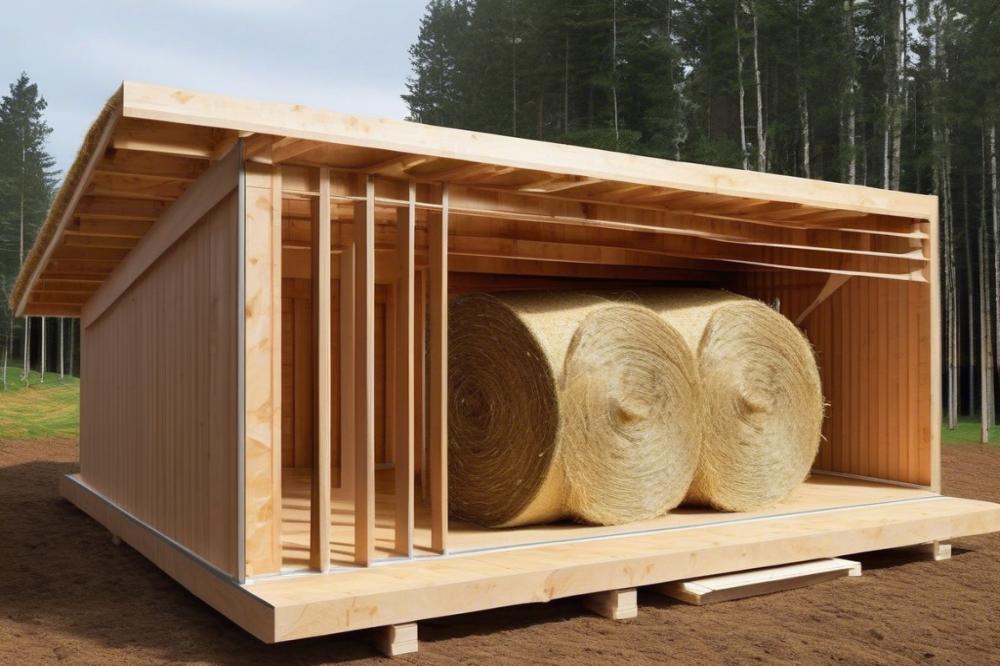Introduction
shed insulation plays a crucial role in maintaining a comfortable environment in outdoor spaces. Insulating a shed properly keeps the interior warm in winter and cool during the summer. This helps in protecting tools and equipment from extreme temperature fluctuations. While traditional materials have been commonly used, there is a growing trend toward eco-friendly alternatives.
Many people are becoming aware of the importance of using sustainable materials in their construction projects. Renewable resources are increasingly preferred for their lower environmental impact. Eco-friendly practices are not just a passing trend; they represent a shift toward more responsible consumption. By choosing the right materials, individuals can contribute positively to their surroundings and promote energy efficiency.
Among these materials, straw bales stand out for their remarkable thermal performance. This method, known as straw bale construction, has been utilized for decades yet is gaining renewed attention in modern building practices. Using straw bales as natural insulation helps to reduce energy costs while supporting green building initiatives. Choosing such techniques not only benefits homeowners but also aligns with broader environmental goals.
Incorporating straw bale insulation into a shed adds value and emphasizes the significance of sustainable building. By exploring this unique approach, builders and homeowners can discover new ways to improve their spaces and embrace eco-conscious living. Adopting alternative insulation methods encourages others to rethink their choices and consider the possibilities of renewable resources.
straw bale insulation

Straw bale insulation is a technique where bales of straw are used to help keep buildings warm in winter and cool in summer. This method relies on the natural properties of straw, which is a byproduct of grain production. Moreover, it serves as an eco-friendly material that can reduce the carbon footprint of any construction project.
Benefits of Using Straw Bales for shed insulation
Using straw bales for shed insulation comes with several benefits. First, this material is highly effective at trapping heat. Structures filled with straw can maintain a comfortable temperature year-round. Budgets can also benefit since straw bales are often less expensive than traditional insulation materials.
Comparison with Traditional Insulation Materials
When compared to conventional insulation options like fiberglass or foam, straw bales stand out. Most traditional insulations can have harmful chemicals that impact indoor air quality. In contrast, straw is all-natural and poses no health risks. While fiberglass may offer good thermal performance, it lacks the sustainability of straw. Straw bales can be sourced locally, further reducing environmental impact during construction.
Role of Straw Bales in Enhancing Thermal Performance
Straw bales significantly improve the thermal performance of buildings. They provide excellent energy efficiency due to their high insulation value. The structure remains stable in extreme weather conditions. With proper installation, straw bale construction can outperform many conventional methods. Overall, using this renewable resource contributes to a greener building approach, aligning with modern sustainability goals.
Eco-Friendly Materials in Shed Construction

Overview of eco-friendly materials for Shed Construction
Building a shed can offer an opportunity to use eco-friendly materials, which support sustainability. Traditional materials often come with a high carbon footprint. In contrast, using resources like recycled wood, reclaimed metal, and natural coatings minimizes environmental impact. Eco-friendly materials can offer durability and style while being kind to the planet.
Importance of Natural Insulation in sustainable building Practices
Natural insulation plays a vital role in green building. It not only improves energy efficiency but also reduces reliance on synthetic options. When creating a comfortable shed, choosing insulation that is made from renewable resources is essential. Using materials that meet environmental standards aligns with sustainable construction goals. Additionally, natural insulation can enhance thermal performance during both winter and summer months.
Straw Bales as a Renewable Resource
Straw bales stand out as a remarkable renewable resource. Traditionally viewed as agricultural waste, they now find a place in construction. Utilizing straw as an insulator is not only effective but also economically beneficial. The availability of straw makes it a sustainable option for those interested in eco-friendly shed insulation. Its natural properties help regulate temperature, making sheds cozy without excessive energy use.
Case Studies of Eco-Friendly Sheds Utilizing Straw Bale Insulation
Several innovative case studies highlight the benefits of straw bale construction in shed design. One noteworthy project in Oregon showcases how an artisanal woodworker built a workshop using straw bales. The structure features excellent insulation techniques, allowing him to work year-round despite fluctuating weather. Another project in California demonstrates how a community center incorporated straw bales. It significantly reduced energy costs while providing a comfortable gathering space for locals. These examples illustrate the practical applications of straw bales, demonstrating their effectiveness in diverse environments.
Insulation Techniques and Methods Using Straw Bales

Implementing straw bale insulation in sheds involves several techniques that focus on maximizing thermal performance while using eco-friendly materials. The first step is selecting the right type of straw bales. Different types offer varied levels of insulation, so it’s important to choose bales made from dense straw for better energy efficiency. When stacking the bales, proper alignment is crucial. They should fit tightly together to minimize gaps that could lead to heat loss.
Best Practices for Installing Straw Bales Effectively
Efficiency in construction largely depends on how well the bales are installed. Start by preparing the foundation of the shed to ensure it can support the weight of the bales. Proper moisture control is essential; dry bales perform better than damp ones. Always wrap the outside of the bales with a breathable material like chicken wire or netting. This protects the bales from pests while allowing any moisture to escape. Sealing the edges with plaster can provide additional protection from the elements.
Combining Straw Bales with Other Insulation Materials
Developers often combine straw bales with other insulation techniques to enhance overall effectiveness. For instance, using cellulose or fiberglass alongside straw can help fill small gaps and increase thermal performance. Additionally, integrating reflective barriers can further improve energy efficiency by reducing heat transfer. Such a hybrid approach takes advantage of the unique properties of each material. Using a variety of natural insulation options supports green building initiatives and creates a sustainable structure.
Evaluation of Insulation Techniques for Energy Efficiency
Evaluating insulation methods helps understand their impact on energy consumption. Studies show that straw bale construction can significantly lower energy costs over time. Measuring thermal performance is key. This involves checking how well the insulation maintains a consistent temperature inside the shed. Using thermal imaging cameras can reveal areas where heat is escaping. With the right insulation techniques, sheds can become more than just storage spaces; they can be comfortable environments. Overall, combining sustainable materials with thoughtful construction can promote the use of renewable resources in shed insulation.
The Benefits of Straw Bale Construction

Overview of Straw Bale Construction Techniques
Straw bale construction involves using compressed bales of straw as building blocks. This method has roots in traditional building practices. Builders stack the bales to create walls, often using them as a core structure for homes and sheds. They are usually covered with a weatherproof layer, such as plaster or stucco. This protects the straw from moisture and pests. Many people find this approach attractive due to its simplicity and resourcefulness.
Advantages of Straw Bale Walls in Shed Building
Using straw bales for shed walls offers various advantages. These bales provide excellent insulation, which is vital for maintaining a comfortable temperature inside the shed. The thick walls made of straw trap heat in winter and keep interiors cool during summer. Such properties make them attractive for those who want to maximize comfort with minimal energy use. Additionally, straw is lightweight yet strong, making it easier to handle during construction.
Impact on Energy Efficiency and Utility Costs
Energy efficiency improves significantly with straw bale insulation. Reduced energy costs become evident when owners notice lower utility bills. This sustainable building technique minimizes the need for heating and cooling systems. Straw bale walls can help regulate indoor temperatures in sheds throughout the year. With proper sealing and construction, drafts and energy loss reduce dramatically.
How Straw Bale Construction Aligns with Green Building Standards
This construction technique matches many green building standards. Eco-friendly materials like straw are renewable resources that benefit the environment. Choosing straw bales promotes sustainable practices, appealing to environmentally conscious builders. Furthermore, using such natural insulation methods supports the goal of reducing carbon footprints. Many organizations recognize straw bale construction as a valid option for green buildings. As a result, it plays a vital role in the growing trend of sustainable building practices.
Challenges and Considerations
Using straw bales in construction presents several challenges that cannot be ignored. Moisture is a primary concern. When bales absorb water, they can lead to mold growth and decay. This makes effective moisture management crucial. Keeping straw dry is essential for maintaining the integrity of shed insulation. Ventilation systems can help remove excess humidity. However, extra effort is needed to monitor conditions regularly.
Pest control is another significant issue. Rodents and insects may find straw attractive. Their presence can compromise the effectiveness of your insulation. Regular inspections and preventative measures should be taken to deter unwanted visitors. Sealing gaps and maintaining clean surroundings can help minimize these risks.
Building Codes and Regulations
Local building codes often dictate what materials are acceptable for construction. Straw bale construction might face scrutiny in some areas. Familiarizing yourself with regulations is important before starting your project. Some regions may require specific treatments for fire resistance or additional structural support. Adhering to these guidelines is vital to comply with safety standards.
Future Trends in Sustainable Shed Construction
Interest in eco-friendly materials grows as climate awareness increases. Straw bales are gaining popularity due to their renewable resources and sustainability. Innovative insulation techniques continue to evolve, improving thermal performance and energy efficiency. This shift reflects a broader trend toward green building practices. Builders are looking for ways to mitigate environmental impact while maximizing comfort. Many anticipate that natural insulation will play a larger role in future construction projects.
Wrapping Up the Benefits of Sustainable Insulation
Straw bales offer significant advantages when it comes to insulation for sheds. They provide a high resistance to heat flow, helping to keep structures cool in the summer and warm in the winter. This not only contributes to comfort but can also reduce energy bills over time. Easy to work with, straw bales require minimal tools and can be adapted to various designs. Their natural composition makes them a great choice for anyone looking to build with eco-friendly materials.
Incorporating sustainable materials into construction projects is more important than ever. As individuals and communities become more aware of environmental impacts, choosing renewable options like straw bales can make a substantial difference. By opting for such materials in shed building, you contribute to a larger movement toward greener practices. More people should consider these materials for their next project.
The future of construction practices looks promising as the demand for eco-friendly solutions increases. Innovative approaches, like using straw as a building component, are gaining traction. If more builders embrace materials that are both sustainable and effective, the benefits could be widespread. Let’s keep pushing for a change that respects our planet while providing functional and beautiful spaces.



